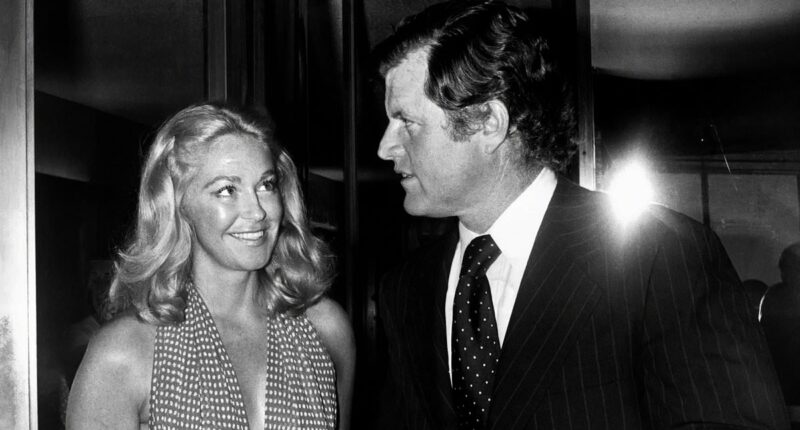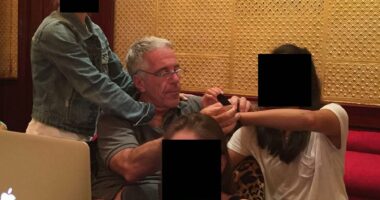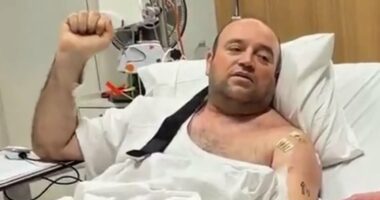Share this @internewscast.com
On Wednesday, Joan Kennedy, ex-wife of the late-senator Ted Kennedy, died at the age of 89. Having outlived her famous sisters-in-law Jackie Kennedy Onassis and Ethel Kennedy, Joan was the last Kennedy wife of her generation. In ‘Ask Not: The Kennedys and the Women They Destroyed,’ Maureen Callahan wrote about Joan’s brutal marriage to Ted and her battles, many private and humiliating. This is an edited extract from Callahan’s book.
It wasn’t her unwanted fame or Ted’s drinking or his other women that broke Joan Kennedy — it was Ted leaving Mary Jo Kopechne for dead at Chappaquiddick. That, Joan said, was when she gave up. That is when Joan Kennedy became a true alcoholic — a hard-core, dawn-to-dusk drinker, food stains on her designer blouses, broken bones and falls, once in a gutter in Boston, rehab after rehab after rehab.
Ted was an alcoholic, too, and a cocaine addict, but he always pointed to Joan and her addiction as his albatross, another liability that might keep him from becoming president.
When Joan was at her best and clearest, Teddy and his advisers loved putting her front and center, on the cover of People or any number of women’s magazines, selling her story of pain and redemption while minimizing her husband’s role in her misery: his drinking and self-pity and verbal abuse and constant, barely-concealed womanizing.
Ted could be downright mean. He would mock Joan’s fading looks, even as his face and belly puffed up from booze and his voracious eating habits.
The media followed Ted’s lead: Joan was the loser, the drunk, the weak one.
This, even though President John F Kennedy had loved Joan. He called her ‘The Dish,’ and after the death of his and Jackie’s newborn son Patrick, it was Joan he confided in — Joan, whose kindness and understanding was a true solace to the young president.

Ted (right) was an alcoholic, too, and a cocaine addict, but he always pointed to Joan (left) and her addiction as his albatross, another liability that might keep him from becoming president

The media followed Ted’s lead: Joan (pictured) was the loser, the drunk, the weak one
‘How swinging should a First Lady be?’
In the run-up to Ted’s inevitable announcement for president, this was what the media focused on: Joan’s looks.
The media, women’s magazines especially, criticized Joan’s miniskirts, her knee-high boots, how she wore her hair and makeup.
They pilloried her for wearing skirts without slips and gowns with side slits.
Even the doctor treating Joan for alcoholism called her assistant, Marcia, and asked if she might convince Joan to tone down her makeup and wardrobe — to look like less of a showstopper and more, well, ladylike.
Ted had put him up to that. Joan knew it.
No one was telling Ted to go on a diet or do something about his ruddy alcoholic complexion or quit drinking altogether, which he really needed to do. No — Joan and her hemlines were the problem.
There was nothing Ted wouldn’t lie about, no corner he wouldn’t cut. He was a supremely unserious man who the media kept propping up as Camelot’s next hope, even as they knew better. Everyone on the Hill knew about the drug box Ted kept in his desk in the Senate.
They’d all heard the story about the 14-year-old girl he’d tried to rape and whose parents he had paid off. Or the high school girl he had hired as an intern and begun having sex with; she was only 17. The waitresses he’d sexually assaulted. The cruises around DC in the back of his limo, rolling down his window, trying to pick up young women.
There was the time Ted caught two of their children using cocaine and, during his subsequent antidrug talk, decided to do a few lines with them. The two abortions at least one of his mistresses had. How about the doctor who would show up to Ted’s office and treat him for gonorrhea?

There was nothing Ted (pictured right with Joan, left) wouldn’t lie about, no corner he wouldn’t cut. He was a supremely unserious man who the media kept propping up as Camelot’s next hope, even as they knew better

The media, women’s magazines especially, criticized Joan’s miniskirts, her knee-high boots, how she wore her hair and makeup

Everyone on the Hill knew about the drug box Ted (pictured left with Joan, right, in 1979) kept in his desk in the Senate
Did Joan ever wonder if, like Jackie, that her miscarriages, or the need for an enormous amount of hormones to get pregnant with their youngest, Patrick, may have been caused by Ted’s constant sexually transmitted infections?
Did Joan know the kind of risk Ted posed to her sexual and reproductive health? Probably not.
Joan, after all, was a virgin when they married.
Few aside from Kennedy wives knew the indignities as Joan did, of slinking away from a party thrown in your own home, only to hear the whispers later that Ted had sex in the library with one of your guests after you went to bed.
Or to have lunch with a friend at the Ritz, seen by all of Boston’s high society, only to learn that that friend, too, had slept with Ted, and that Joan was the last to know.
Or to have your husband picking up women and bringing them, along with his supplicant aide, back to the house to do lines of cocaine and have sex while the children were upstairs, presumably asleep.
Those encounters usually took place in the jacuzzi that Ted had installed in the backyard for threesomes.
The only other humiliation that came close was Ted walking a reporter out to their parked car, where Joan had passed out. ‘Do you see what I have to deal with?’ he asked.
Ted had long ago left Mary Jo Kopechne, the 28-year-old Kennedy campaign aide, to die a slow, agonizing death, alone, after he crashed his car into three feet of water at Chappaquiddick.
Mary Jo had been a virgin, too. And she died as one.

In the run-up to Ted’s inevitable announcement for president, this was what the media focused on: Joan’s looks

Did Joan (left) know the kind of risk Ted (right) posed to her sexual and reproductive health? Probably not

It wasn’t her unwanted fame or Ted’s drinking or his other women that broke Joan Kennedy — it was Ted leaving Mary Jo Kopechne for dead at Chappaquiddick. (Pictured: Ted and Joan leaving the funeral Mass for Mary Jo Kopechne)
In 1976, three years before Ted formally began his run for president of the United States, Joan checked into a New York City rehab facility.
One of her fellow patients in group therapy sold Joan’s confessions to the National Enquirer, among them her criticisms of Ethel (‘you don’t dare discuss sex in front of [her] . . . and there’s no sex education for the kids’), Rose Kennedy (a ‘harridan’ who ‘has a fit when she thinks I don’t behave properly’) and the family itself.
‘I’m not as bright as they are,’ Joan said, ‘and I’m so tired of being the dumb blonde of the Kennedy family… I’ve never been able to compete.’
Even Jackie Kennedy Onassis, whom Joan claimed to have the most in common with, wasn’t spared.
Joan’s complicated feelings towards the sister-in-law she most admired and envied — and who kept Joan at a certain remove, despite Joan’s wish for a closer relationship — were unleashed in one of these sessions.
‘Jackie has always been the queen,’ Joan said. ‘She can’t stand competition from anybody. And considering how the other Kennedy girls look, I guess Jackie felt I was the only Kennedy who could be competition for her. Jackie and I were never very close.’
Joan spoke of hitting her limit and exploding during a Kennedy family gathering.
‘I ran through every one of the damn Kennedys like a machine gun. I’d just had enough. I’d had it up to here. I blasted them all to their face… I let them know exactly how I feel about them. That was the only time you could hear a pin drop in a room full of Kennedys… It was something I’d wanted to do for a long time but I hadn’t had the courage. I decided I wasn’t going to be a mouse anymore.’
The mouse, indeed, had roared.

Few aside from Kennedy wives knew the indignities as Joan (center in 1965) did, of slinking away from a party thrown in your own home, only to hear the whispers later that Ted (left) had sex in the library with one of your guests after you went to bed

Joan’s (left) complicated feelings towards the sister-in-law (right) she most admired and envied — and who kept Joan at a certain remove, despite Joan’s wish for a closer relationship — were unleashed in one of these sessions

Joan spoke of hitting her limit and exploding during a Kennedy family gathering: ‘I ran through every one of the damn Kennedys like a machine gun. I’d just had enough. I’d had it up to here.’ (Pictured: Joan in 2015)
As for her vaunted rival: Jackie was in psychoanalysis, too, and in 1975 had gotten a job as a book editor in New York, working at Viking for $200 a week.
If the most famous woman in the world could earn her own money, derive self-esteem from using her brain and carve out a post-Kennedy identity for herself while confronting her demons — well, why couldn’t Joan?
She went back to school to get her master’s in education, even though she doubted she would ever really teach.
‘I want the credibility that little piece of paper will give me,’ she said. ‘Once I have that, I won’t just be Joan Kennedy. That’s important for a lot of women my age.’
She was only 41. No woman in political life besides Betty Ford had ever been so open about her struggles with addiction and mental health.
‘I couldn’t believe how hard it was to stop,’ Joan told People magazine of her drinking. ‘Alcoholism is a baffler. I was a periodic drinker, not a daily one, but God knows, toward the end of my drinking—talk about being enslaved!’
Her sobriety had set her free, in many ways.
It had given her a sense of who she was, what she wanted, and how to stand up for herself.
‘It was hard for Ted at first,’ she said, ‘because I used to say, “Yes, dear,” to everything. And now I can say, “No.”‘















